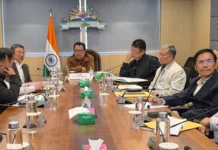[ Badak Yomgam ]
The Yomgo river, originating as the Yargyap Chu river in Arunachal Pradesh’ Shi-Yomi district, is a vital waterway carving its path through the Himalayas before converging with the mighty Siang river at Sangam. It also receives water from the Sipu river, which flows through Aalo. The river is a lifeline for communities along its banks, especially Aalo, providing water for agriculture and fishing opportunities and deeply influencing their culture identity and traditions.
This strong community reliance and cultural integration form a natural basis for sustainable rural tourism, where visitors can engage directly with traditional practices like local fishing techniques and understanding the traditional uses of river resources, supporting the local economy directly.
For adventure enthusiasts, the Yomgo river offers white-water rafting through exhilarating rapids amidst stunning scenery. Its diverse ecosystem also provides opportunities for fishing and observing riverine wildlife (animals and plants that live in and around rivers and their associated ecosystems), fostering a respectful connection with its biodiversity. These activities, when managed responsibly, can contribute to sustainable tourism by promoting environmental awareness and conservation of the pristine waters and riparian habitats (unique areas of land and vegetation that are directly adjacent to and influenced by bodies of water, such as rivers, streams, lakes, ponds and even intermittent waterways like washes or seeps).
The Yomgo river also serves as a destination for relaxation, with serene spots along its banks for contemplation, picnics and unwinding amidst the natural environment. The diverse terrain along its course offers opportunities for trekking and photography, with trails leading through varied landscapes and providing stunning vistas. Such activities promote a low-impact form of tourism, emphasizing appreciation for nature and offering opportunities for visitors to connect with the pristine environment away from daily demands, thereby supporting the preservation of these tranquil areas.
Culturally, The Yomgo river is deeply integrated into the indigenous communities’ lives. Culture tourism here involves participating in or observing river-centric traditions, rituals and daily life. The annual ‘Yomgo River Festival’, celebrated typically in the early part of the year, often in February or April, in Kamba in West Siang district, showcases the rich heritage of indigenous Galo communities through traditional dances, folk music, cuisines, ornaments and textiles.
This festival serves as a vital occasion for community engagement and the intergenerational transfer of knowledge, offering invaluable opportunities for youths to preserve and continue their heritage. By directly supporting such cultural events and local crafts, visitors contribute to the economic wellbeing of the communities, helping to sustain their unique cultural identity and fostering a deep sense of pride among the local population. This active engagement and support of local traditions and events are key components of sustainable rural tourism, ensuring that tourism benefits the local communities and helps preserve their unique way of life.
The Yomgo river, therefore, stands not only as a majestic natural wonder but also as a dynamic force for cultural affirmation, community sustenance and an exceptional destination for both adventure and serene contemplation, deeply intertwined with the lives and traditions of the Galo tribe of Arunachal. Its multifaceted appeal provides a strong foundation for developing sustainable rural tourism that benefits both visitors and the local communities by preserving natural resources and cultural heritage. (The contributor is a PhD scholar at NEHU, Shillong)



